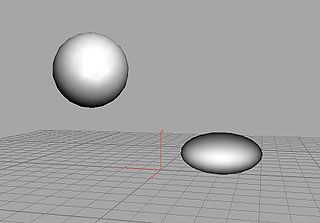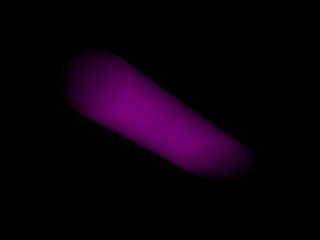-
Notifications
You must be signed in to change notification settings - Fork 124
ExamplesProceduralsDeformationBlur
This example injects two different geometries at two different time samples creating deformation blur.

opengl

renderman
Motion blur is defined in a very similar fashion to RenderMan. First we call motionBegin() with a list of time samples. You can have as many motion samples as your renderer will allow. For each time sample we then inject some geometry. It is important that the topology remain consistent between time samples, otherwise the renderer will complain. We finish by calling motionEnd(). Remember not to inject anything but geometry samples between motionBegin() and motionEnd().
In general the code will look like:
renderer.motionBegin( [ sample1, sample2, ... ] )
sample1_geometry.render( renderer )
sample2_geometry.render( renderer )
...
renderer.motionEnd()Note: Don't forget to turn on motion blur in your renderer!
Note: In OpenGL all samples will be rendered simultaneously. Refer to the [ExamplesProceduralsRenderingModes Render Mode] example for code that can differentiate based on which renderer is currently rendering.
#=====
# Deformation Blur
#
# This cookbook example injects two different geometries at different time
# two time samples creating deformation blur.
#
# Motion blur is defined in a very similar fashion to RenderMan. First we call
# motionBegin() with a list of time samples. You can have as many motion samples
# as your renderer will allow. For each time sample we then inject some
# geometry. It is important that the topology remain consistent between time
# samples, otherwise the renderer will complain. We finish by calling
# motionEnd(). Remember not to inject anything but geometry samples between
# motionBegin() and motionEnd().
#
# Don't forget to turn on motion blur in your renderer
#
# In OpenGL all samples will be rendered simultaneously. Refer to the
# RenderSwitch example for code that can differentiate based on which renderer
# is currently rendering.
#
# In general the code will look like:
#
# renderer.motionBegin( [ sample1, sample2, ... ] )
# sample1_geometry.render( renderer )
# sample2_geometry.render( renderer )
# ...
# renderer.motionEnd()
#
#=====
from IECore import *
class deformationBlur(ParameterisedProcedural) :
#=====
# Init
def __init__(self) :
ParameterisedProcedural.__init__( self, "DeformationBlur procedural." )
geo1 = PathParameter( name="geo1", description="Geometry #1",
defaultValue="test_data/deform1.cob" )
geo2 = PathParameter( name="geo2", description="Geometry #2",
defaultValue="test_data/deform2.cob" )
self.parameters().addParameters( [geo1, geo2] )
#=====
# It's important that the bounding box extend to contain both geometry
# samples.
def doBound(self, args) :
bbox = Box3f()
geo1 = Reader.create( args['geo1'].value ).read()
geo2 = Reader.create( args['geo2'].value ).read()
bbox.extendBy( geo1.bound() )
bbox.extendBy( geo2.bound() )
return bbox
#=====
# Nothing to do
def doRenderState(self, renderer, args) :
pass
#=====
# Render our two motion samples
def doRender(self, renderer, args):
# load our geometry
geo1 = Reader.create( args['geo1'].value ).read()
geo2 = Reader.create( args['geo2'].value ).read()
# get the shutter open/close values from the renderer
shutter = renderer.getOption('shutter').value # this is a V2f
# if motion blur is not enabled then both shutter open & close will
# be zero.
do_moblur = ( shutter.length() > 0 )
# inject the motion samples
renderer.motionBegin( [ shutter[0], shutter[1] ] )
geo1.render( renderer )
geo2.render( renderer )
renderer.motionEnd()
#=====
# Register our procedural
registerRunTimeTyped( deformationBlur )- Introduction
- General Functionality
- Data Handling
- Parameters and Ops
- Point Primitives
- Mesh Primitives
- Image Primitives
- Procedurals
- Cortex & Python
- Cortex & Maya
- Cortex & Houdini